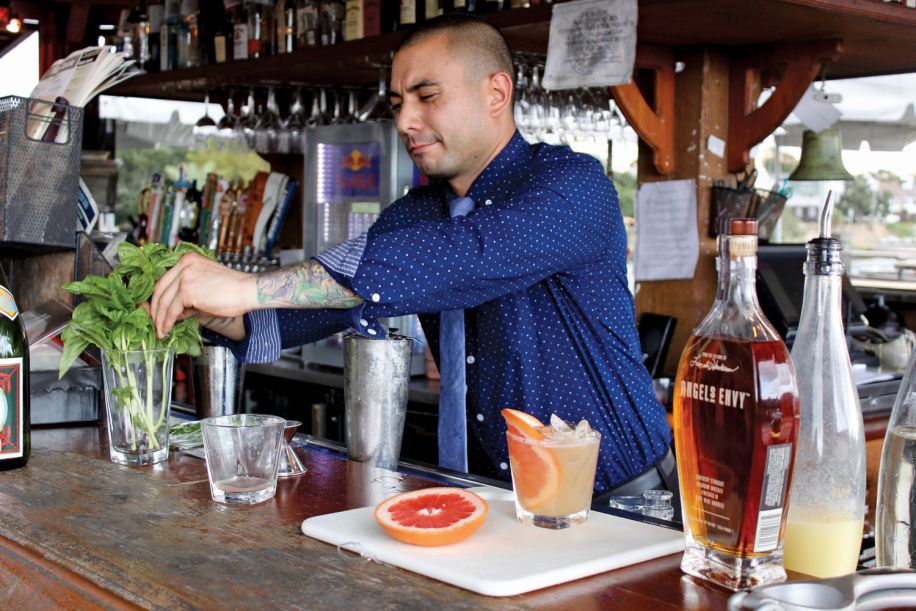What’s mixology? If you’re one for semantics, you might already be picking apart the syllables and coming to the conclusion that it’s the study of mixing. However, as Great Southern Bar Mixologist Shaun Dixon would tell you, mixology is a bit more complicated than that. Making drinks is equal parts art, science and hospitality; although you must be creative-minded to concoct new drink ideas, you also have to stick with a formula that helps you achieve an ideal flavor balance, all while remembering to maintain a sincere smile and pleasant demeanor as you’re crafting the cocktail. Downtown Crowd caught up with the mixolot master Dixon, who schooled us on the topic of mixology and the chemistry behind your favorite drink(s).
MIXOLOGIST V. BARTENDER
Marking the difference between a mixologist and a bartender has been a point of contention for some. Ask most professionals and they’ll tell you there should be no difference between the two. However, “mixologist” has come to describe a bartender who shows greater enthusiasm and interaction with the crowd, showing genuine interest in satisfying each customer not only by delivering a correct order but by delivering excellent service, too. The story goes that the word “bar” is short for “barricade,” which separates the bartender from the crowd. Following that line of thought, using “mixologist” instead of “bartender” is believed to soften that divide between the person behind the bar and his/her audience.
THE (WO)MAN BEHIND THE MIXER
So, what makes a master mixer? First is recognizing that behind the bar you’re both a gracious host and enthusiastic entertainer. Learning how to craft drinks is just a fraction of the job, since a certain degree of social finesse and positive attitude are certainly as important, if not more, as getting the drink right. Dixon’s piece of advice may seem simple enough, but it may prove more difficult in practice: “Be nice and smile.” Also, remember the “-ology” part in mixology comes not only in studying how to mix drinks, but on studying your audience; get to know your guest, find out whether they prefer pumpkin spice or caramel, and you’ll be well on your way to making a yummy drink because it’ll be tailored to your guest’s taste.
CRAFTING A COCKTAIL
When crafting a cocktail, the general ratio to keep in mind is the bartending rule of thumb—2:1:1, meaning “two parts spirit, one part sweet, and one part sour.” Brown spirits tend to be the toughest in terms of finding a complementary flavor, while vodka, gin, tequila, rum and whiskey all have characteristic profiles that make a good starting point for whatever flavor-combo ideas you might have. Sweet comes in a countless variety of options, whether it’s syrups, saps or fruits, and sours come in just as many innumerable variations (with the safe go-to being either fresh-squeezed lemon or lime juice). Other menu-based, flavor-combos that have worked for centuries: tomato and basil, yogurt and cucumber, cilantro and lime, mustard and honey, chilies and oregano.
TASTE TEST
Once you’ve crafted your cocktail, whether a new invention or new take on an old classic, it’s time to put it to the test. After all, you can’t serve up a new drink without making sure the average bar guest will enjoy it. Gather up a group of some honest beta-testers—whether it’s your neighbors, friends, family members, or coworkers. What you’re looking for are comments on balance; you want to hear that each ingredient highlighted the distinctive qualities of another without completely overriding it. Generally speaking, if you can get at least 8 out of 10 to nod in approval, then your concoction has passed the taste test. Cheers!
WANT MORE MIXOLOGY?
Atlas Beverage Classes: A Tour Through Japan
Oct. 6 (5 pm, 7 pm)
Atlas Oyster House
$20/person
850-217-2347
